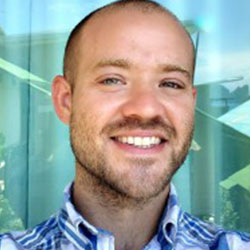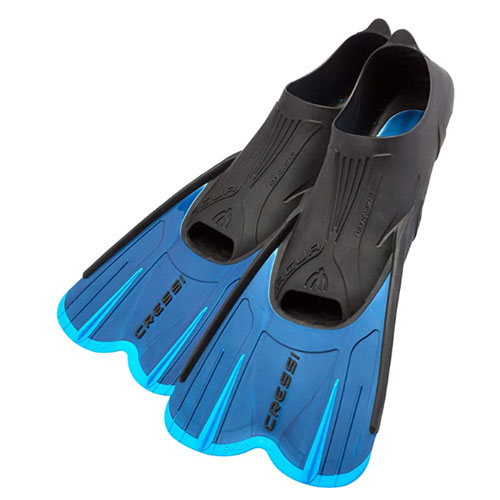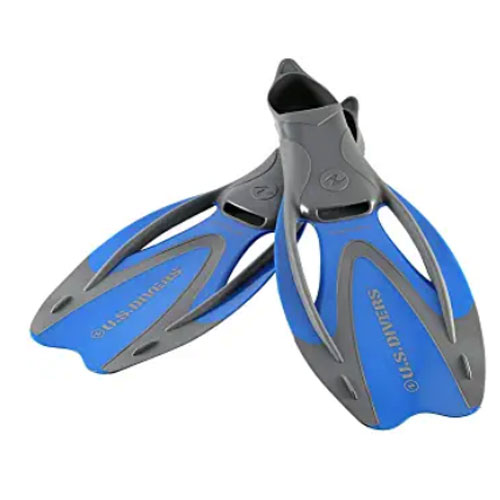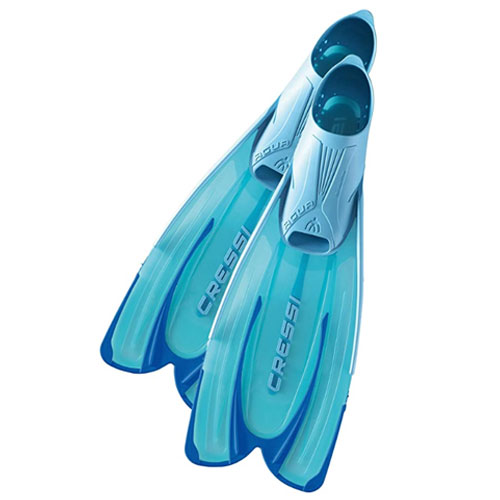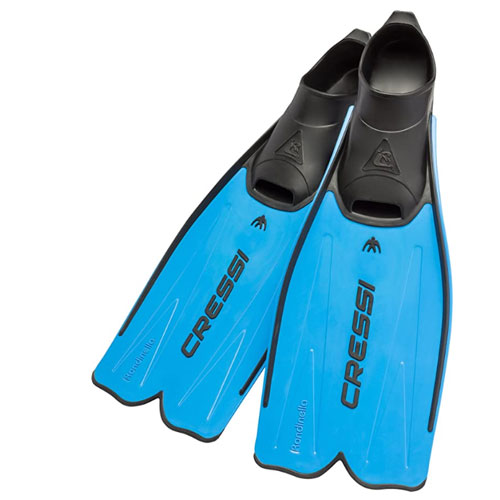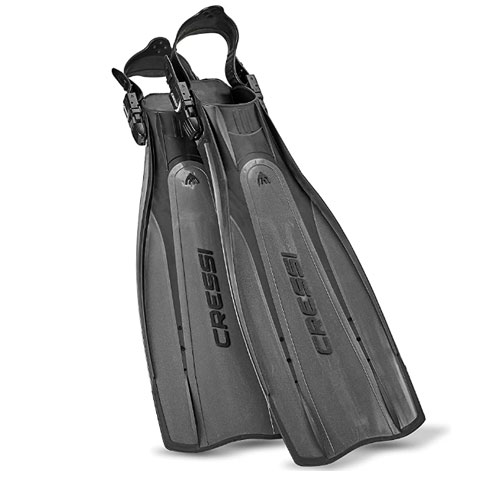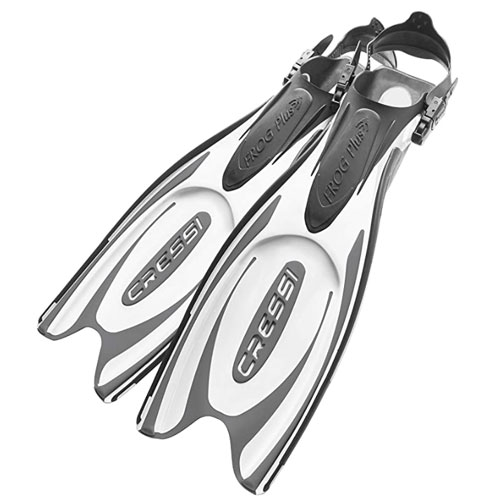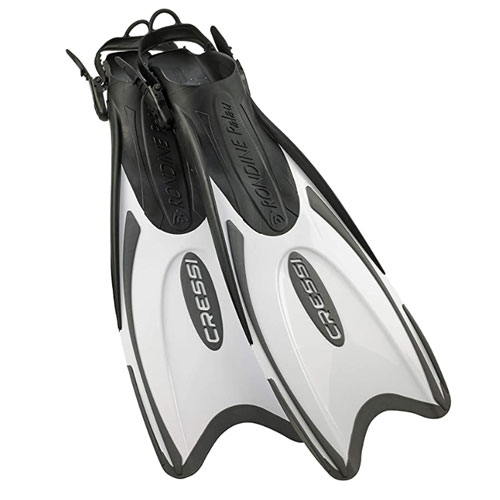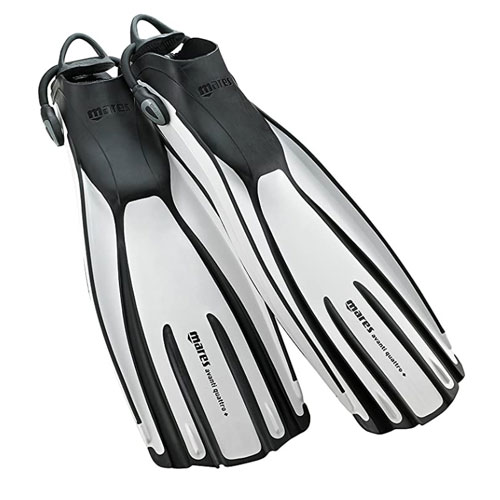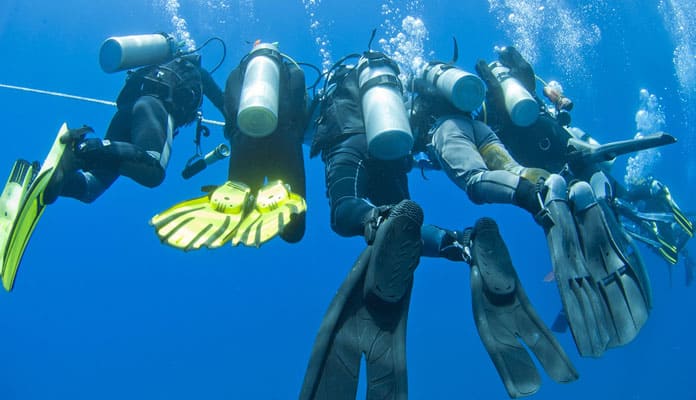
Responsible for speed and agility underwater, dive fins are one of the most important pieces of scuba equipment. A well-made pair of scuba diving fins will maximize your kicking power, so you can move through the water easily without losing too much energy.
Looking for the best scuba fins means considering factors like size, fit, blade design, and foot comfort. To help you in your search, this article will take a look at the best scuba diving fins that are guaranteed to perform great on every dive.
OUR TOP PICK
Cressi Agua Short Fins
- Stand Out Features - Why We Love It
- Short and responsive blade for higher precision and maneuverability
- Self-adjusting foot pocket feels great on any foot shape and size
- Soft Thermo-rubber pocket for optimal foot comfort
- Lightweight and compact so it’s great for traveling
- Very energy-efficient (great even for inexperienced divers)
Best For: Maneuverability and Precision
Heel Type: Closed
Material: Polypropylene/ Thermo-rubber (Blade), Thermo-rubber (Foot Pocket)
Vented: No
Sizes: US 4/5 to US 13/14 (men’s)
EDITORS CHOICE
U.S. Divers Proflex II Fins
- Stand Out Features - Why We Love It
- Vented blade design makes kicking easier
- Dual composite blade improves energy transfer
- Each fin size covers 3 regular shoe sizes
- Pull tab on the heel for putting the fin on easily
- Mesh carry bag included (safe to pack when wet)
Best For: Powerful Propulsion
Heel Type: Closed
Materials: Dual Composite (Blade), Rubber (Foot Pocket)
Vented: Yes
Sizes: S (US 4 to 7) to L (US 10 to 13 men’s)
BEST VALUE
Cressi Agua Long Fins
- Stand Out Features - Why We Love It
- Soft thermo-rubber pocket provides top-level comfort
- Polypropylene blade makes kicking easy and efficient
- Full-length blade for impressive speed underwater
- Lightweight and responsive so it doesn’t tire your feet
- Incredibly affordable considering the fin quality
Best For: Performance on a Budget
Heel Type: Closed
Material: Polypropylene/ Thermo-rubber (Blade), Thermo-rubber (Foot Pocket)
Vented: No
Sizes: US 4/5 to 11.5/12.5 (men’s)
Cressi Rondinella Fins
- Stand Out Features - Why We Love It
- Easy to use and suitable for beginners
- Extra-soft rubber foot pocket for all-day comfort
- Rubber veins in the blade improve flexibility
- Closed heel with a pull tab to easily put it on
- Blade on top of the foot pocket (better energy transfer)
Best For: Beginner Divers
Heel Type: Closed
Materials: Polypropylene (Blade), Thermo-rubber (Foot Pocket)
Vented: No
Sizes: US 3.5/4.5 to 13/14 (men’s)
Cressi Pro Light Fins
- Stand Out Features - Why We Love It
- Long side rails for directing the water flow better
- Open heel with a quick-release rubber strap
- Comfortable foot pocket prevents fatigue and cramps
- Blade on top of the pocket for maximizing every kick
- Large number of men’s and women’s sizes and colors
Best For: Instructors and Technical Divers
Heel Type: Open
Materials: Polypropylene/Elastomer (Blade), Elastomer (Foot Pocket)
Vented: No
Sizes: US 6/7 to 15/16 (men’s)
Cressi Frog Plus Fins
- Stand Out Features - Why We Love It
- Injection-molded from 3 materials for optimal performance
- Dual-density techno polymer blade transfers kick energy well
- Below-blade pocket position increases working surface up to 20%
- Channeling design improves the efficiency on both kicks (up and down)
- Covered by a 2-year limited manufacturer’s warranty
Best For: Different Kicking Techniques
Heel Type: Open
Materials: Dual-Density Polymer, Silicone, Rubber
Vented: No
Sizes: US 3/6 to 10/13 (men’s)
Cressi Rondine Palau Fins
- Stand Out Features - Why We Love It
- Each model covers a larger number of regular shoe sizes
- Open heel and elastic strap adjust well to any foot
- Quick-release buckle on the strap to easily remove the fin
- Long blade design for improved speed when kicking
- Full-length rigid side rails for directing the water flow
Best For: Adjustability and Comfort
Heel Type: Open
Materials: Polymer, Silicone, Rubber
Vented: No
Sizes: US 4/6.5 to 11/13 (men’s)
Mares Avanti Quattro Plus Fins
- Stand Out Features - Why We Love It
- Excellent responsiveness with great thrusting power
- Channel Thrust Technology (controlled blade twisting)
- High-Flex blade materials boost its performance
- Anatomical foot pockets for a higher comfort level
- Entirely made of comfortable Tecralene rubber
Best For: Thrust and Responsiveness
Heel Type: Open
Material: Thermoplastic rubber (Tecralene)
Vented: No
Sizes: S to XL (US 15)
Mares Avanti Superchannel Fins
- Stand Out Features - Why We Love It
- Superchannel design makes water glide down the fin
- Tecralene rubber is exceptionally comfortable to wear
- Upper and lower vertical stabilizers (no wobbling)
- Higher kicking efficiency compared to similarly-sized fins
- Orthopedic foot pocket doesn’t cause blisters or discomfort
Best For: Kick Efficiency
Heel Type: Closed
Material: Thermoplastic Rubber (Tecralene)
Vented: No
Sizes: US 6.5/7.5 to 11/12
Scubapro GO Travel Fins
- Stand Out Features - Why We Love It
- Bungee-corded strap for getting the fin on and off easily
- Foot pocket and strap are very comfy on a bare leg
- Piggy Back System makes them safe for carry-on luggage
- 25° angled blade makes kicking more energy-efficient
- Central Power Panel for rigidity and water channeling
Best For: Traveling
Heel Type: Open
Material: Monoprene
Vented: Yes
Sizes: 3XS to 2XL
How To Choose The Best Scuba Diving Fins – Buying Guide
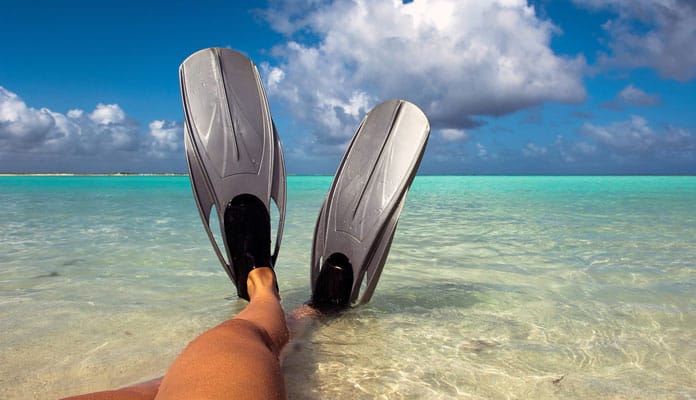
Intended Use
Before you start looking for the best fins, you should think about how and where you want to use them. If you’re going to use your fins exclusively for scuba, you want a long and rigid dive fin that can propel you through the water. On the other hand, if you’ll enjoy occasional snorkeling too, a softer and more flexible fin will do a better job.
You might also be interested in:
Size and Fit
Besides propulsion power, the fit is probably the most important thing to consider when buying a fin. A well-fitted diving fin should be snug around your foot – neither too tight nor too loose. If it’s too tight, it will cause blisters and discomfort. If it’s too large, your foot will move inside and you might even lose it.
As you’ve had the chance to see, fins are available in both men’s and women’s sizes. However, a single fin size often encompasses several regular shoe sizes (8 to 10 for example). We advise that you get your regular shoe size and, if possible, try the fins on before buying.
If you need some additional warmth on your feet and plan to wear neoprene socks, it’s best to go with divers fins that are a half or full size larger. Keep in mind, however, that larger fin sizes have longer blades that might make packing inconvenient.
Durability
Fins are going to be under a lot of stress underwater, so they need to be made from tough and durable materials. Various combinations of sophisticated plastic and rubber polymers are used to make the fins, but not all of them perform equally well.
From the durability standpoint, the best diving fin is made from a single material using the injection-molding method. However, this often isn’t the ideal solution performance-wise. Since most modern scuba flippers are made from at least two materials, make sure that the joints between them are strong and well made because these are the most common weak points.
Color
The color of your fins plays a much bigger role than you might think. For example, choosing a color that blends well into the surroundings won’t scare off marine life, which is particularly important if you’re spearfishing.
If you are swimming with sharks, black is recommended as it doesn’t attract as much attention. On the flip side, if you’re leading a group into the water (and there are no sharks), the best fins for diving are brightly-colored so you stay easily visible.
Related Review: Swim Fins
Comfort
The fins for scuba you choose are going to be on your feet for long periods, so they need to be very comfortable. Two factors play big roles here – size and foot pocket materials. Since we’ve already covered fin sizing, we’ll briefly discuss the materials.
The foot pocket should be made of soft rubber that won’t chafe your foot or cause blisters. Unfortunately, not all of us have the same foot shape, so a firmer fin might cause problems. Softer materials with an adjustable heel strap can do wonders here, so keep that in mind when choosing.
Propulsion
Propulsion is the force a fin generates to move you through the water. The technology is constantly improving, so newer diving flippers experiment with different materials and fin angles to give you a better thrust with less energy.
If you want the best propulsion, look for a fin that is long and has channels. Additionally, vents or a split blade design might boost the performance too.
Open vs Closed Heel
When it comes to foot pocket design, there are two options – open and closed heel. An open heel is open at the back and has a strap to keep your foot in the pocket. It’s easier to put on and remove, and gives you a higher level of adjustability.
On the other hand, a closed heel system offers a more streamlined fit. This type is less bulky on the foot and doesn’t require any straps. However, finding the right size might be an issue, and it won’t always allow you to wear a sock underneath.
Fin Parts
To make understanding fins easier, we are going to say a thing or two about different elements that you can find on scuba diving fins. Some of them are standard on all fins, while others are only found on certain models.
Blade: It’s the main part of the fin that propels you through the water. Blades can be softer (require less energy) or firmer (move you faster). They can be made from several different materials like rubber, plastic, carbon fiber, monoprene, or fiberglass.
Foot Pocket: As its name suggests, this is the part where your foot goes. It’s usually made from a softer material than the blade. It can have an open or closed heel, each with its own advantages.
Channels: These are softer sections that run down the length of a firm blade and change how the blade moves the water. Instead of going to the sides, water goes down the blade making the kick more efficient.
Side Rails: Rails are vertical blade reinforcements that add firmness to the sides. They make moving in a straight line easier and improve energy transfer.
Vents: Designed as slits in the blade, vents reduce the amount of resistance your foot experiences when kicking up. This allows you to generate more power and reduces joint strain.
Heel Straps: Found in open heel fins, straps keep your foot inside the pocket. They are usually made of rubber or a bungee cord, meaning that they are elastic and don’t press on the heel too much. Furthermore, many of the best fins for scuba diving have an adjustable strap and a quick-release buckle.
Blade type
There are many different types of blades. This can affect your dive by making them more efficient which will give you more power with less effort.
- Standard fins are ones that you instantly think of when you hear scuba fins. They have a flat piece of material that usually has ribs running down the length of the flippers.
- Split blades have a large slit down the middle of the fin. This allows water to flow between each blade which reduces water resistance giving you more power. This is a newer type of fin that has quickly become a favorite in the diving community.
FAQs

Q: What Are Scuba Diving Fins?
Scuba diving fins are basically paddles that you wear on your feet. They consist of a blade (the working part) and a foot pocket that goes on your foot just like are regular shoe or sock. Thanks to their design, your kicks will have a lot more power so you can move around with less effort.
Q: Why Do I Need Special Scuba Diving Fins?
The truth is that you do not need special fins, but they make the dive infinitely more enjoyable. Scuba diving fins allow you to swim efficiently and explore the water without getting tired. As a bonus, they also keep your feet warm and protected.
Q: How To Size My Diving Fins?
Fins should have a snug fit on your feet, without being too tight. Because of this, we advise that you get the same fin size as you would a regular shoe size. If you’re unsure about this, it’s a good idea to get a pair that has an adjustable strap. Additionally, make sure to get a slightly larger fin if you plan to wear neoprene socks.
Q: How To Care For My Scuba Fins?
After each dive, you should rinse your fins with fresh water. This will help dissolve the salt in the seams, while also removing sand and other debris. If your fins are particularly dirty, you can submerge them in warm soapy water and wash them with a sponge (rinse off afterward).
Before storing, always make sure to dry the fins off (so they don’t get moldy) but avoid drying them in direct sunlight as this can damage the materials.
Q: Do I Need Open Or Closed Heel Fins?
It comes down to your personal preference, as both have their advantages. Closed heel fins are more comfortable on bare feet, have less drag, and feel warmer in the water. However, they are not very adjustable. Open heel fins, on the other hand, adjust to different foot lengths (more precise fit) and get on and off more easily.
Globo Surf Overview
Your overall diving experience depends in large part on the equipment you’re using. Even though diving fins are not crucial like a tank or wetsuit, they are the most important piece for moving efficiently underwater.
For this reason, you should always take your time and choose a pair of fins that are suited for your diving style and fit well on your feet. We hope that our scuba fin reviews have pointed you in the right direction, so you can take your underwater adventures to a new level.
More Scuba Reviews:
- Dive Camera
- Bcd For Beginners
- Full Face Scuba Mask
- Dive Watches Under 200
- Dive Watch Under 1000
- Dive Watches Under 500
- Ladies Dive Watch
- Underwater Scooter
- Scuba Regulator
- Rebreather


